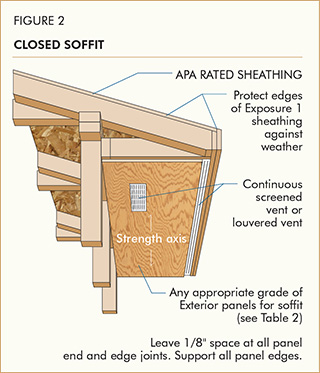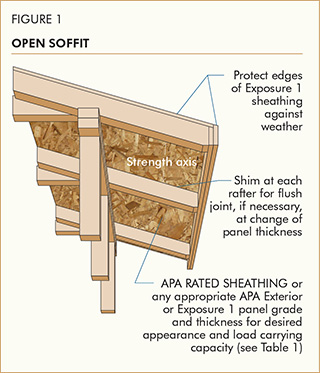Are you wondering what plywood to use for soffit? Well, you’ve come to the right place! Choosing the right type of plywood for your soffit is essential for both aesthetics and durability. So let’s dive in and explore the options.
When it comes to selecting plywood for your soffit, you’ll want to consider a few things. First off, marine-grade plywood is a popular choice due to its superior moisture resistance and ability to withstand outdoor conditions. Additionally, exterior-grade plywood is another viable option as it is designed to withstand the elements.
Now, you might be wondering about the thickness of the plywood. Generally, 1/4 inch or 3/8 inch thick plywood is commonly used for soffits, but it ultimately depends on the specific requirements of your project. So, let’s explore the different types of plywood and find the perfect fit for your soffit needs!

What Plywood to Use for Soffit: A Comprehensive Guide
Soffit is an essential component of any building’s exterior. It not only adds architectural appeal but also protects the eaves and rafters from weather damage. When it comes to choosing the right plywood for soffit installation, there are several factors to consider, including durability, moisture resistance, and aesthetic appeal. In this guide, we will explore the different types of plywood suitable for soffit applications and help you make an informed decision for your project.
1. Understanding Soffit: What It Is and Why It Matters
Soffit is the visible underside of the eaves or roof overhangs, typically found between the outer wall and the roofline. Apart from providing a finished look to the exterior, soffit also plays a crucial role in ventilation, preventing moisture buildup, and protecting the structural components of the building. It acts as a barrier against insects, birds, and other pests while improving the overall energy efficiency of the structure.
When choosing plywood for soffit, it is important to select a material that can withstand outdoor conditions and perform well over an extended period. The plywood used for soffit needs to be durable, water-resistant, and able to withstand temperature fluctuations. Additionally, it should have a smooth and visually appealing surface, as it will be visible from various angles.
2. Marine Grade Plywood: Ideal for Moisture-Prone Areas
Marine grade plywood is one of the top choices for soffit applications, especially in regions with high humidity or coastal areas. Made from high-quality hardwood or tropical wood species, marine grade plywood is specifically designed to resist water damage and fungal growth. It is constructed using waterproof glue and has excellent structural integrity, making it highly suitable for outdoor use.
The superior moisture resistance of marine grade plywood makes it an ideal choice for soffit installation. It ensures that the plywood retains its strength and integrity even in the face of heavy rainfall or exposure to moisture-laden air. Additionally, marine grade plywood offers good dimensional stability, meaning it won’t warp or swell when exposed to changing weather conditions.
Benefits of Marine Grade Plywood for Soffit:
– Exceptional moisture resistance, suitable for high humidity environments
– Superior durability and structural integrity
– Resistant to fungal growth and rot
– Performs well in outdoor conditions
– Smooth surface finish for an aesthetically pleasing look
3. Exterior Grade Plywood: Affordable and Versatile
Another commonly used plywood for soffit applications is exterior grade plywood. It is a cost-effective option that offers good weather resistance and durability. While not as moisture-resistant as marine grade plywood, exterior grade plywood is suitable for areas with moderate moisture exposure, such as in regions with mild climates.
Exterior grade plywood is manufactured using waterproof glue and is designed to withstand outdoor conditions. It is typically constructed from softwood or hardwood veneers, providing good strength and stability. The surface of exterior grade plywood may not be as smooth as marine grade plywood, but it can still be painted or finished to achieve a visually appealing appearance.
Benefits of Exterior Grade Plywood for Soffit:
– Affordable option for soffit applications
– Resistant to weather and moderate moisture exposure
– Good strength and stability
– Can be painted or finished for customization
– Versatile and readily available in various thicknesses and sizes
4. Other Options to Consider: Hardwood and Fiber Cement Soffit
Apart from marine grade and exterior grade plywood, there are a few other options to consider for soffit installation. Hardwood plywood is known for its strength and aesthetic appeal. It offers natural beauty and can be an excellent choice if you want to achieve a high-end look for your soffit. However, it may require additional maintenance and refinishing over time.
Fiber cement soffit boards are also gaining popularity due to their durability and low maintenance requirements. Made from a mixture of cement, cellulose fibers, and silica, fiber cement boards offer excellent resistance to moisture, rot, and insects. They are available in various styles and finishes, allowing for customization and design flexibility.
Choosing the Right Plywood for Your Soffit Project
When selecting plywood for soffit, consider the climate and environmental conditions of your area, as well as your budget and desired aesthetic. Marine grade plywood is the top choice for areas with high humidity or coastal regions, offering exceptional moisture resistance and durability. Exterior grade plywood provides a cost-effective option for moderate moisture exposure and mild climates. Additionally, hardwood plywood and fiber cement soffit boards offer unique advantages in terms of strength, aesthetic appeal, and customization.
Ensure that the plywood you choose meets the required industry standards and is installed according to the manufacturer’s guidelines. Proper installation and regular maintenance will help prolong the lifespan of your soffit and ensure its optimal performance. By selecting the right plywood for your soffit project, you can enhance the beauty, functionality, and longevity of your building’s exterior.
Key Takeaways: What Plywood to Use for Soffit?
- Choose exterior-grade plywood for soffit to ensure durability.
- Opt for plywood with a smooth surface to create a polished finish.
- Consider using plywood with a high-quality veneer for an attractive appearance.
- Look for plywood with a thickness that suits your specific soffit design and requirements.
- Ensure the plywood is properly sealed and primed before installation to prevent moisture damage.
Frequently Asked Questions
When it comes to installing a soffit, choosing the right plywood is crucial. Here are some commonly asked questions to help you understand what plywood to use for a soffit.
Q: What are the different types of plywood suitable for a soffit?
When it comes to choosing plywood for a soffit, there are a few options to consider. One popular choice is exterior-grade plywood, such as ACX or BCX. These types of plywood are specifically designed to withstand the elements and are moisture-resistant, making them ideal for outdoor applications like soffits. Another option is marine plywood, which is specifically engineered to resist rot and decay even in wet conditions. Marine plywood is a great choice for soffits in areas prone to high humidity or moisture exposure. Additionally, you can opt for hardwood plywood, which is durable and provides an attractive finish for your soffit.
Overall, the key is to select a plywood type that is resistant to moisture, durable, and suitable for outdoor applications. It’s essential to choose a high-quality plywood that will stand the test of time and maintain the structural integrity of your soffit.
Q: What thickness of plywood should I use for a soffit?
The thickness of plywood you should use for a soffit depends on various factors, such as the span distance and the load it needs to support. In general, for a standard soffit installation, 3/8″ thick plywood is commonly used. This thickness provides adequate strength and stability for most soffit applications. However, if the span distance is longer or if you anticipate additional weight on the soffit, you may need to consider using thicker plywood, such as 1/2″ or 5/8″. Be sure to consult a structural engineer or a professional contractor to determine the appropriate thickness for your specific soffit project.
Remember, using the right thickness of plywood is crucial for the structural integrity of the soffit. It ensures that the soffit can properly support its own weight and any additional loads that may be imposed on it.
Q: Can I use pressure-treated plywood for a soffit?
While pressure-treated plywood is commonly used for outdoor applications, it is generally not recommended for soffit installations. The chemicals used to treat pressure-treated plywood can be harmful when in close proximity to living spaces or areas where people frequently gather. These chemicals, such as chromated copper arsenate (CCA), are intended to protect the wood from rot and insect infestation but are not suitable for interior or semi-enclosed spaces.
It is best to use exterior-grade or marine plywood for soffit installations, as they are designed to withstand moisture and provide the necessary durability. If you have specific concerns about termite protection or moisture resistance, consult with a professional contractor who can guide you in selecting the appropriate plywood for your soffit.
Q: Can I paint the plywood used for a soffit?
Yes, you can paint the plywood used for a soffit to match the overall aesthetic of your home. However, it is important to properly prepare the plywood surface for painting. Start by sanding the plywood to create a smooth surface. Next, apply a primer to improve paint adhesion and ensure a long-lasting finish. Finally, use an exterior-grade paint that is suitable for outdoor applications and provides protection against the elements.
Keep in mind that regular maintenance may be required to keep the painted plywood in good condition. Make sure to inspect the soffit periodically and touch up any areas where the paint may have chipped or peeled. This will help prolong the life and appearance of your soffit.
Q: Can I use plywood with a veneer finish for a soffit?
Using plywood with a veneer finish for a soffit is a matter of personal preference and the desired appearance of the soffit. A veneer finish adds a layer of real wood veneer on the surface of the plywood, giving it a more natural and refined look. This can be particularly appealing if you want your soffit to have a premium aesthetic. However, keep in mind that veneered plywood may require additional care and maintenance compared to other types of plywood.
If you choose to use plywood with a veneer finish, it is crucial to select a high-quality product to ensure durability and resistance to moisture. Additionally, proper sealing and maintenance will help protect the veneer surface and maintain its appearance over time. Consult with a professional contractor or a specialist at a reputable supplier to ensure you choose the right veneered plywood for your soffit project.

Summary
When choosing plywood for soffit, it’s important to consider its durability and resistance to moisture. Exterior grade plywood, such as CDX or ACX, is the best option as it can withstand outdoor conditions. Avoid using interior grade plywood as it may not hold up well against the elements and can lead to rot and damage. Additionally, ensure that the plywood is properly installed, providing proper ventilation to prevent moisture buildup and prolong the life of the soffit.
In summary, choose exterior grade plywood for soffit, as it is durable and resistant to moisture. Avoid using interior grade plywood and ensure proper installation for maximum longevity.
